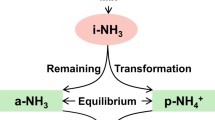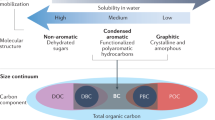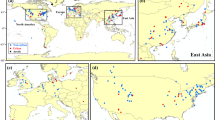Abstract
Atmospheric phosphorus fertilizes plants and contributes to Earth’s biogeochemical phosphorus cycle. However, calculations of the global budget of atmospheric phosphorus have been unbalanced, with global deposition exceeding estimated emissions from dust and sea-salt transport, volcanic eruptions, biogenic sources and combustion of fossil fuels, biofuels and biomass, the latter of which thought to contribute about 5% of total emissions. Here we use measurements of the phosphorus content of various fuels and estimates of the partitioning of phosphorus during combustion to calculate phosphorus emissions to the atmosphere from all combustion sources. We estimate combustion-related emissions of 1.8 Tg P yr−1, which represent over 50% of global atmospheric sources of phosphorus. Using these estimates in atmospheric transport model simulations, we find that the total global emissions of atmospheric phosphorus (3.5 Tg P yr−1) translate to a depositional sink of 2.7 Tg P yr−1 over land and 0.8 Tg P yr−1 over the oceans. The modelled spatial patterns of phosphorus deposition agree with observations from globally distributed measurement stations, and indicate a near balance of the phosphorus budget. Our finding suggests that the perturbation of the global phosphorus cycle by anthropogenic emissions is larger thanpreviously thought.
This is a preview of subscription content, access via your institution
Access options
Subscribe to this journal
Receive 12 print issues and online access
$259.00 per year
only $21.58 per issue
Buy this article
- Purchase on Springer Link
- Instant access to full article PDF
Prices may be subject to local taxes which are calculated during checkout





Similar content being viewed by others
References
Peñuelas, J. et al. Human-induced nitrogen–phosphorus imbalances alter natural and managed ecosystems across the globe. Nature Commun. 4, 2934 (2013).
Vitousek, P. M., Porder, S., Houlton, B. Z. & Chadwick, O. A. Terrestrial phosphorus limitation: Mechanisms, implications and nitrogen–phosphorus interactions. Ecol. Appl. 20, 5–15 (2010).
Broecker, W. S. Ocean chemistry during glacial time. Geochim. Cosmochim. Acta 46, 1689–1705 (1982).
Handoh, I. C. & Lenton, T. M. Periodic mid-Cretaceous oceanic anoxic events linked by oscillations of the phosphorus and oxygen biogeochemical cycles. Glob. Biogeochem. Cycles 17, 1092 (2003).
Rockström, J. et al. A safe operating space for humanity. Nature 461, 472–475 (2009).
Smil, V. Phosphorus in the environment: Natural flows and human interferences. Annu. Rev. Energy Environ. 25, 53–88 (2000).
Camarero, L. & Catalan, J. Atmospheric phosphorus deposition may cause lakes to revert from phosphorus limitation back to nitrogen limitation. Nature Commun. 3, 1118 (2012).
Wu, J. et al. Phosphate depletion in the western North Atlantic Ocean. Science 289, 759–762 (2000).
Okin, G. S. et al. Impact of desert dust on the biogeochemistry of phosphorus in terrestrial ecosystems. Glob. Biogeochem. Cycles 18, GB2005 (2004).
Graham, W. F. & Duce, R. A. Atmospheric pathways of the phosphorus cycle. Geochim. Cosmochim. Acta 43, 1195–1208 (1979).
Mahowald, N. et al. Impacts of biomass burning emissions and land use change on Amazonian atmospheric phosphorus cycling and deposition of phosphorus. Glob. Biogeochem. Cycles 19, GB4030 (2005).
Mahowald, N. et al. Global distribution of atmospheric phosphorus sources, concentrations and deposition rates, and anthropogenic impacts. Glob. Biogeochem. Cycles 22, GB4026 (2008).
Tipping, E. et al. Atmospheric deposition of phosphorus to land and freshwater. Environ. Sci.: Processes Impacts 16, 1608–1617 (2014).
Bertine, K. K. & Goldberg, E. D. Fossil fuel combustion and the major sedimentary cycle. Science 173, 233–235 (1971).
Chen, Y. et al. Global mercury emissions from combustion in light of international fuel trading. Environ. Sci. Technol. 48, 1727–1735 (2014).
Wang, R. et al. Sources and pathways of polycyclic aromatic hydrocarbons transported to Alert, the Canadian High Arctic. Environ. Sci. Technol. 44, 1017–1022 (2010).
Meij, R. Trace element behavior in coal-fired power plants. Fuel Process. Technol. 39, 199–217 (1994).
Raison, R. J., Khanna, P. K. & Woods, P. V. Mechanisms of element transfer to the atmosphere during vegetation fires. Can. J. Forest Res. 15, 132–140 (1985).
Cotton, F. A. & Wilkinson, G. Advanced Inorganic Chemistry: A Comprehensive Text 3rd edn, 381–383 (Interscience Publishers, 1972).
Beck, J. et al. The behaviour of phosphorus in flue gases from coal and secondary fuel co-combustion. Fuel 84, 1911–1919 (2005).
Smith, R. et al. Characterization and formation of submicron particles in coal-fired plants. Atmos. Environ. 13, 607–617 (1979).
Mamane, Y. et al. Characterization of individual fly ash particles emitted from coal-and oil-fire power plants. Atmos. Environ. 20, 2125–2135 (1986).
Olmez, I. et al. Compositions of particles from selected sources in Philadelphia for receptor modeling applications. J. Air Pollut. Control Assoc. 38, 1392–1402 (1988).
Mahowald, N. et al. Observed 20th century desert dust variability: Impact on climate and biogeochemistry. Atmos. Chem. Phys. 10, 10875–10893 (2010).
Neff, J. C. et al. Increasing eolian dust deposition in the western United States linked to human activity. Nature Geosci. 1, 189–195 (2008).
McDowell, R. W. & Sharpley, A. N. Atmospheric deposition contributes little nutrient and sediment to stream flow from an agricultural watershed. Agric. Ecosyst. Environ. 134, 19–23 (2009).
Lamarque, J. F. et al. Historical (1850-2000) gridded anthropogenic and biomass burning emissions of reactive gases and aerosols: Methodology and application. Atmos. Chem. Phys. 10, 7017–7039 (2010).
Monks, P. S. et al. Atmospheric composition change–global and regional air quality. Atmos. Environ. 43, 5268–5350 (2009).
Shindell, D. et al. Simultaneously mitigating near-term climate change and improving human health and food security. Science 335, 183–189 (2012).
Mahowald, N. Aerosol indirect effect on biogeochemical cycles and climate. Science 334, 794–796 (2011).
Wang, R. et al. High resolution mapping of combustion processes and implications for CO2 emissions. Atmos. Chem. Phys. 13, 5189–5203 (2013).
Van der Werf, G. R. et al. Global fire emissions and the contribution of deforestation, savanna, forest, agricultural, and peat fires (1997–2009). Atmos. Chem. Phys. 10, 11707–11735 (2010).
Schultz, M. G. et al. Global wildland fire emissions from 1960 to 2000. Glob. Biogeochem. Cycles 22, GB2002 (2008).
Wang, R. et al. Trend in Global Black Carbon Emissions from 1960 to 2007. Environ. Sci. Technol. 48, 6780–6787 (2014).
Wang, R. et al. Black carbon emissions in China from 1949 to 2050. Environ. Sci. Technol. 46, 7595–7603 (2012).
Wang, R. et al. Exposure to ambient black carbon derived from a unique inventory and high resolution model. Proc. Natl Acad. Sci. USA 111, 2459–2463 (2014).
Balkanski, Y. et al. Direct radiative effect of aerosols emitted by transport: From road, shipping and aviation. Atmos. Chem. Phys. 10, 4477–4489 (2010).
Jaenicke, R. Abundance of cellular material and proteins in the atmosphere. Science 308, 73 (2005).
Andres, R. J. & Kasgnoc, A. D. A time-averaged inventory of subaerial volcanic sulfur emissions. J. Geophys. Res. 103, 251–261 (1998).
Bergametti, G. et al. A mesoscale study of the composition of aerosols emitted from Mt. Etna Volcano. Bull. Volcanol. 47, 1107–1114 (1984).
Sansone, F. et al. Geochemistry of atmospheric aerosols generated from lava-seawater interactions. Geophys. Res. Lett. 29, 49-1–49-4 (2002).
Han, C. et al. Free atmospheric phosphine concentrations and fluxes in different wetland ecosystems, China. Environ. Pollut. 159, 630–635 (2011).
Devai, I. & DeLaune, R. D. Evidence for phosphine production and emission from Louisiana and Florida marsh soils. Org. Geochem. 23, 277–279 (1995).
Han, S. H. et al. Phosphorus cycling through phosphine in paddy fields. Sci. Total Environ. 258, 195–203 (2000).
Aselmann, I. & Crutzen, P. J. Global distribution of natural freshwater wetlands and rice paddies, their net primary productivity, seasonality and possible methane emissions. J. Atmos. Chem. 8, 307–358 (1989).
Schumann, U. & Huntrieser, H. The global lightning-induced nitrogen oxides source. Atmos. Chem. Phys. 7, 3823–3907 (2007).
Granier, C. et al. Evolution of anthropogenic and biomass burning emissions of air pollutants at global and regional scales during the 1980–2010 period. Climatic Change 109, 163–190 (2011).
Price, C. G., Penner, J. E. & Prather, M. J. NOx from lightning, Part I: Global distribution based on lightning physics. J. Geophys. Res. 102, 5229–5241 (1997).
Acknowledgements
The authors thank Ether/ECCAD for distribution of emission data used in this study. We thank B. G. Li, F. Zhou, W. M. Hao, Y. Ying and M. McGrath for discussions, and J. Gash for editing the English. R.W. was supported by the ‘FABIO’ project, a Marie Curie International Incoming Fellowship from the European Commission. This work was also conducted as part of the ‘IMBALANCE-P’ project of the European Research Council (ERC-2013-SyG-610028). S.T. was supported by the National Nature Science Foundation of China (41390240, 41130754) and the 111 Program (B14001). Some of the computations were performed using HPC resources from GENCI-TGCC (grant 2014-t2014012201).
Author information
Authors and Affiliations
Contributions
R.W. designed the research, performed all calculations and analysed the uncertainties. All authors took part in interpreting the results and writing the paper.
Corresponding author
Ethics declarations
Competing interests
The authors declare no competing financial interests.
Supplementary information
Supplementary Information
Supplementary Information (PDF 1899 kb)
Rights and permissions
About this article
Cite this article
Wang, R., Balkanski, Y., Boucher, O. et al. Significant contribution of combustion-related emissions to the atmospheric phosphorus budget. Nature Geosci 8, 48–54 (2015). https://doi.org/10.1038/ngeo2324
Received:
Accepted:
Published:
Issue Date:
DOI: https://doi.org/10.1038/ngeo2324
This article is cited by
-
A global dataset on phosphorus in agricultural soils
Scientific Data (2024)
-
Effects of nitrogen and phosphorus additions on soil microbial community structure and ecological processes in the farmland of Chinese Loess Plateau
Journal of Arid Land (2023)
-
Atmospheric dust intrusions from the peninsular region into the Northern Gulf of California: case study
Earth Science Informatics (2023)
-
Nitrogen enrichment enhances the competition for nitrogen uptake between Stipa purpurea and microorganisms in a tibetan alpine steppe
Plant and Soil (2023)
-
Drivers of soil microbial and detritivore activity across global grasslands
Communications Biology (2023)



